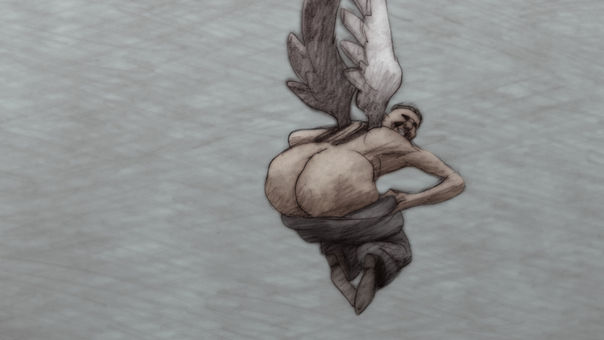Sketching creative freedom
Bill Plympton's IDIOTS AND ANGELS is a case study of both the benefits and the perils of individual artistic freedom, writes Ulisés Pérez Mancilla of the 2011 Talent Press Guadalajara

IDIOTS AND ANGELS.
Bill Plympton had only one dream as a boy: to work for Disney Studios. After unsuccessfully presenting his sketches as an adolescent, rejection became a fascinating goal. In time, he founded his own company: Plymptoons. He created the character of a neurotic dog who yearned to be the equivalent of Mickey Mouse and he won himself a couple of Oscar nominations. Years later, this sufficed for Disney to return his calls, and an attempt to recruit him into their ranks. It was, however, too late; Plympton was already used to making up his own rules. This is what directors call creative freedom (or self sufficiency).
IDIOTS AND ANGELS, the story of a man, an anti-hero, who feels conflicted about wings that have begun to grow on his back, is the ideal example of the risks taken by Bill Plympton while creating his work. On the one hand, he shows with splendor the freedom he has in orchestrating his own creations; while on the other, interest in the story soon fades as it is eclipsed by his artistic form.
The film has its own style of traditional drawing, shaded with imperfect silhouettes, like a subtle edition of elliptic vignettes, comparable perhaps with the organic delight of binding pages into a book. Few contemporary films can afford the luxury of transgressing comfortable language and construct frame by frame their own interpretation of cinematographic language; in this case, reminiscent of a graphic novel. A cinematographic language is complimented by this almost ingenious spontaneous darkness with which the author seals the passing of time. Here, Plympton takes advantage of exaggeration to give depth to his characters, beginning with their features.
Diverging widely from the conventional standards of animation, however, the director inevitably stumbles down so many paths that he enters the story without the audience ever really empathizing beyond the mere anecdote. The fortunate construction of metaphors and mundane spaces within the film quickly become reinforcements for meaning and end up giving a pretext for more and more transgressing-artistic-authorial brush strokes, but with a weak compromise towards a seductive narrative.
The fantastic anecdote about the possibility of flying is unnecessarily drawn out. So much so, in fact, that the author contradicts his own “creative freedom”. Even that which in the beginning appeared to be genuine nonchalance ends up retracting itself, becoming a deceptive moral lesson, that within all of the elements uses sexual screenplays that always end up retracting themselves. At the end, the strange redemption of the character, whose strength lies on the dark side, even within the chaos of the plot, separates itself with no evident intention of offering explanations about what is being drawn.
For this reason, it would be an interesting exercise to switch the jobs of author and director (who has declared himself happy telling short stories without dialogue) and investigate the result of Plympton’s genius by using a different script. If what is important lies in the foundation and not in the form, or in the fortunate fusion of both, would a Pixar plot not deserve to end up in the hands of Plympton? Within the uncertain, both plot and form would be condemned to being fortunate complementary elements.

